A La Réunion, les documents stratégiques mettent en exergue le caractère exceptionnel de la biodiversité et les besoins de gestion et de conservation de ce patrimoine naturel, récemment labélisé par l’UNESCO. Parmi les fiches actions consacrée à la biodiversité tropicale au service de l’économie du vivant, la S3 rappelle : « La reconnaissance de l’exceptionnalité écologique des Mascareignes impose une gestion spécifique de ce patrimoine unique au monde, au service du développement économique des populations. Ces milieux uniques, largement défrichés au cours des trois derniers siècles et désormais réduits à un tiers du territoire réunionnais, sont aujourd’hui menacés par de nombreuses espèces exotiques, devenues envahissantes et le changement climatique mettant en péril ces flores insulaires vulnérables ».
Dans ce contexte à fort enjeu pour l’économie du territoire et à forte responsabilité internationale, les acteurs et les décideurs ne disposent pas d’indicateurs précis et reproductibles de l’évolution de la biodiversité au sein des milieux naturels de La Réunion. Les inventaires disponibles basés sur des listes d'espèces ne rendent pas compte des différents compartiments de la diversité des organismes et des écosystèmes du bien patrimoine mondial ainsi que de leur dynamique.
Afin de répondre aux objectifs et aux ambitions de la S3, de développer des filières économiques qui reposent sur l’endémicité des espèces de La Réunion et la préservation de leur milieu le projet DIVINES propose de mettre en œuvre les actions de recherche et de développement suivantes :
- déployer un réseau de dispositifs permanents au sein des différents écosystèmes naturels de La Réunion qui fournisse un état de référence pour les opérations de restauration écologique, et qui permette un suivi à long terme de la dynamique des écosystèmes,
- réaliser des inventaires de biodiversité innovants, réunissant dans un même site des technologies récentes d’acquisition de données (protocoles standardisés au plan international, numérisation / bancarisation en temps réel, métagénomique, inventaires couvrant des taxons et des groupes différents (arthropodes, mollusques terrestres, plantes hôtes vasculaires, indigènes et exotiques, épiphytes, micro-organismes),
- rendre permanent le réseau pour un suivi en temps réel des changements des conditions climatiques (P, T, RH) et des ressources biologiques (taux d’invasion, niveau d'endémisme),
- fournir des indicateurs de biodiversité et des cartes de répartition de la biodiversité, de l'endémisme et de leurs relations avec les caractères physiques du territoire (climat, topographie), en utilisant des outils d’analyse spatiale tels que la télédétection et les SIG.
Ces inventaires quantitatifs et durables de la biodiversité vont produire des collectes et des banques de tissus qui serviront de spécimens de référence (voucher) pour les acteurs impliqués dans la valorisation du vivant (e.g. éco-extraction). Les données collectées, l’abondance, la répartition spatiale, la diversité phylogénétique des taxons endémiques de La Réunion seront saisies dans une base de données interfaçable avec TAXREF et le SINP.
L’analyse de ces données et la modélisation de la distribution spatiale des espèces permettront de produire de nouveaux outils pour les acteurs locaux en charge de la gestion et de la valorisation des milieux naturels et de transférer ces connaissances vers les gestionnaires. En particulier, les zones à fort potentiel évolutif, et/ou au risque d’extinction élevé pourront être identifiées et priorisées pour la conservation. Le projet permettra de renforcer l’expertise sur le territoire, de former plusieurs étudiants réunionnais dans le cadre de la préparation de leur master et de leur doctorat, de créer des compétences locales en ingénierie écologique.
Financement : FED-FEDER
Partenaires et bailleurs :
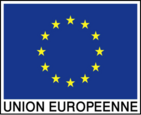


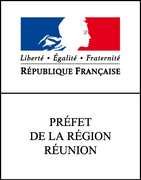

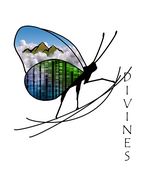
The themes of this interdisciplinary project are "Global Change and Impact on the Natural Environment and its Biological Response” and "Natural Hazards." The main objectives are to improve knowledge of the eruptive history of Piton de la Fournaise (frequency and intensity) and of two main volcanic hazards, using botanical and chemical study using a native pioneer plant species on lava flow, Bois de Rempart (BR) (Agarista salicifolia). This tree has a germination and installation capacity only on new substrates devoid of vegetation. It is not only the dominant species on lava flows, but also a long-lived tree and unusable wood.
Study procedure is as follows:
(1) Dating the pen flows out of volcanic enclosure, from the BR diameter measured on recent and known age lava flows,
(2) Dating major volcanic gas emissions by dendroisotopic analysis of BR cellulose (Anomaly = 180 presence of volcanic gases).
The aim is to produce a new map of volcanic hazards for Piton de la Fournaise sides.
As a result of its optimal geographic position, the station is the ideal place for students and researchers working on this program.
FUNDING: OSU-Réunion, Federation OMNCG
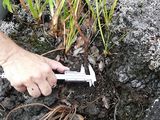
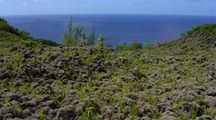
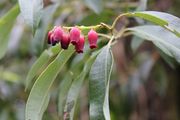
The aim of this project is to set up study areas on three archipelagos (Canaries, Azores, Reunion), develop appropriate methodologies and implement a fast, efficient and long-term biodiversity monitoring system in three large groups of functionally interdependent organisms: flowering plants, macro-invertebrates living above ground and micro-invertebrates living in the soil.
The research station received the first group of 3 entomologists during 2 months in 2012: 3 entomologists, Juliane Casquet , postdoc in the lab "Evolution and Biodiversity" at the University Paul Sabatier of Toulouse, Noémie Mollaret, a temporary contract and Samuel Danflous, Head of Research at the Conservatory of Natural Areas in Midi-Pyrenees, specialist of arthropods and African spiders.
In each of the 10 plots, they sampled spiders, beetles and springtails. The study of these three very different groups on three remote islands should provide better understanding of biodiversity distribution within an ecosystem and between similar ecosystems. It should also determine whether all groups respond equally to the effect of distance distribution. The final goal is to provide knowledge to improve biodiversity management and conservation on these three archipelagos.
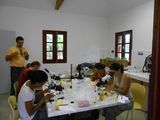
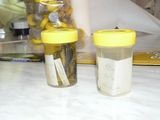
Recent climate change has deeply affected the unique and vulnerable polar and high mountain ecosystems. However, due to limited knowledge, high uncertainty remains regarding similar effects on tropical biotas. In the present project, we propose to study and promote tropical bryophytes and ferns as bioindicators of climate change. These highly diverse plants, widely acknowledged as crucial ecosystem components, remain among the least known groups.
This project MOVECLIM sets up the first comparative analysis of tropical biodiversity along altitudinal gradients in multiple islands. It assembles an international and multidisciplinary network across the islands of La Réunion (Mascarenes), Guadeloupe (Antilles), Pico (Azores), La Palma (Canaries) and Tahiti (French Polynesia). Partners with expertise in the field of biodiversity research and conservation include universities, research centres and national parks.
The intended project specifically aims to:
(1) Characterise bryophyte and fern diversity along altitudinal gradients from lowland to summit and from the gene to community level,
(2) Relate species diversity and distribution patterns to relevant life-history and functional traits,
(3) Compare relationships between diversity and predictors across the islands,
(4) Model species response to climate change in terms of range shifts,
(5) Establish permanent plots for long-term vegetation monitoring. Scientific networking will include intensive sampling and environment monitoring across the islands.
Novel modelling approaches will help infer the relationships between species performance and local conditions. The derived results will bring new evidence regarding species and community responses to climate change.
Overall, the results will be highly relevant for conservation managers and decision-makers. The original participation of local stakeholders (National Parks of Guadeloupe and Réunion) to a common research project will insure results transfer to conservation managers. The deliverables include joint publications, as well as training the next generation of field taxonomists and developing tools for conservation managers to promote sustainable biodiversity management.

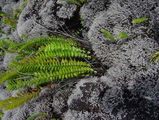
The Pl@ntNet project has two main objectives: to facilitate (1) access to plant identification and (2) exchange of botanical information. Different computer solutions are implemented and evaluated with partner networks to meet the needs in these areas. A 15-day mission has been planned in close collaboration with Reunion’s PVBMT laboratory. This mission, involving people from various institutes specializing in different disciplines, will allow PVBMT researchers to interact with their partners working on Pl@ntNet issues and to guide future developments for the local context.

Ecology of pollination in orchid Gastrodia similis in La Reunion
This project is part of a research program on chemical mediators of the relationship in plant-insect pollination.
Research laboratory at the University of KwaZulu-Natal headed by Professor Steven Johnson is an international leader in this field, and has just acquired a high tech lab equipment: the coupling gas chromatography - mass spectrometry - Electroantennography (GC-MS-EAG), which simultaneously allows to identify and quantify the volatile compounds emitted by the flower, and analyze the action potential (= response) induced by each of these compounds on the sensory organs insects (= antenna). The scent of the flower is more or less complex volatile compounds mixture, only some play a role in attracting insects pollination. It is therefore necessary to explore the many pollination systems found in nature in order to better understand the various ways of chemical mediation developed by flowering plants.
The orchid Gastrodia similis, endemic to La Reunion, shows an original mode of pollination. The flowers appear only for a short period in August of each year, produce a fruity scent at dawn, and until late afternoon. In this way, they draw fruit flies, which deluded by the smell, trying to feed and lay eggs inside them, and then realize pollination. A first pollination of G. similis was observed in Reunion, and an advanced scientific study seems interesting for several reasons:
- The ecology of this endemic orchid is beginning to be identified in La Reunion. We know that this non chlorophyll plant depends on a saprophytic fungus that feeds carbon throughout its life cycle. However, we know a little about the reproduction of this species;
- This is one of the first description of mimicry fruit (fruit mimicry) within the large family of orchids. Pollination by flies is well known in this family, but when flowers mimic corpses or fungi ordor;
- Volatile compounds associated with this floral mimicry are not described. It could be an imitation of compounds found in Drosophila major resources in the natural habitat of the orchid, lowland tropical rainforest, especially “bois de pomme” (Syzygium spp.). That which would also explain the presence of populations of G. similis in forests invaded in Syzygium jamrosa;
- Drosophila organizations are undisturbed by human presence, which facilitates their observation. They are, for most species, easy to raise and lend themselves well to laboratory experiments, as electroantennography (EAG). In addition, the response induced by different families of volatile compounds present in fruits in Drosophila melanogaster, has been well studied. The interpretation of our results could therefore be based on this fundamental knowledge.
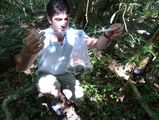
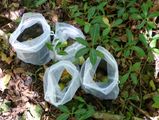
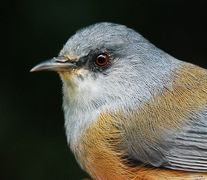
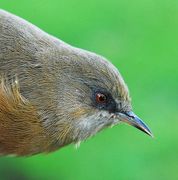
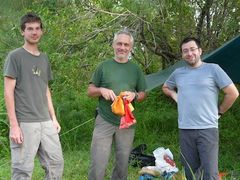
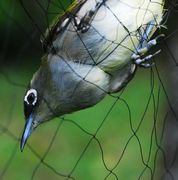
Ecology and Evolutionary Biology of Zoizo White (White-eye Bourbon, Zosterops borbonicus)
Director: Christophe Thebaud (Paul Sabatier University)
Team: Borja Mila, Joris Bertrand, Yann Bourgeois, Josselin Cornuault, Boris Delahaie, Thomas Duval
Biodiversity edification on distant oceanic islands is influenced by the arrival of settlers and their possible diversification into multiple species even within archipelagos islands. In birds, it is generally considered that diversification of island species is mainly due to dispersal between islands. The formation of new species within the same island seems generally impossible for islands smaller than Madagascar, because the differentiation of daughter populations from an ancestral population requires geographical barriers that do not seem to be sufficient on small islands. The Mascarene White-eye, a species endemic to Reunion, provides a notable exception to this observation. White-eye presents an extraordinary microgeographic variability of plumage coloration and behaviour (vocals) on the scale of the island. Since 2007, Christophe Thebaud and his Paul Sabatier University team in collaboration with Borja Mila, from Madrid Natural History Museum, have led a series of genetic and ecological studies that have shown the evolution of differences between different geographical variants of recent origin which have taken place within Reunion Island, and may be related to changes in a small number of genes. The Mascarene White-eye represents a possible case of current formation of new species in a spatial scale unprecedented in birds. The research team currently focuses on the dispersal abilities of birds and connectivity between populations, hybridization in contact zones between morphs, the analysis of a type of colour polymorphism in upland birds and co-evolutionary dynamics between White-eye and blood parasites, especially agents of avian malaria.
Seismological data recorded on oceanic islands make it possible to analyse waves via their signature in micro-seismic noise (amplitude, direction and frequency) and better understand the structure of the crust and mantle. The temporary station installed by the University of Reunion Island with financial support from INSU, OSUR ANR is part of the RHUM-RUM seismic network (Project leader: G. Barruol and K. Sigloch) whose main goal is a better imaging Reunion hotspot.
*IPGP : The Paris Institute of Earth Physics is organized into fourteen research teams. Their composition and detailed research topics can be found on the IPGP website.
« The fourteen research groups (and three observatories) are part of a single structure under the umbrella of CNRS. IPGP is a partner of Denis Diderot-Paris 7, Pierre et Marie Curie-Paris 6 and Reunion Island universities and the ENS (Ecole Normale Supérieure).
IPGP research is conducted in metropolitan France and overseas mainly on the campuses of Jussieu (Paris) and Saint-Maur, as well as in Volcanic, Seismological and Magnetic observatories.»